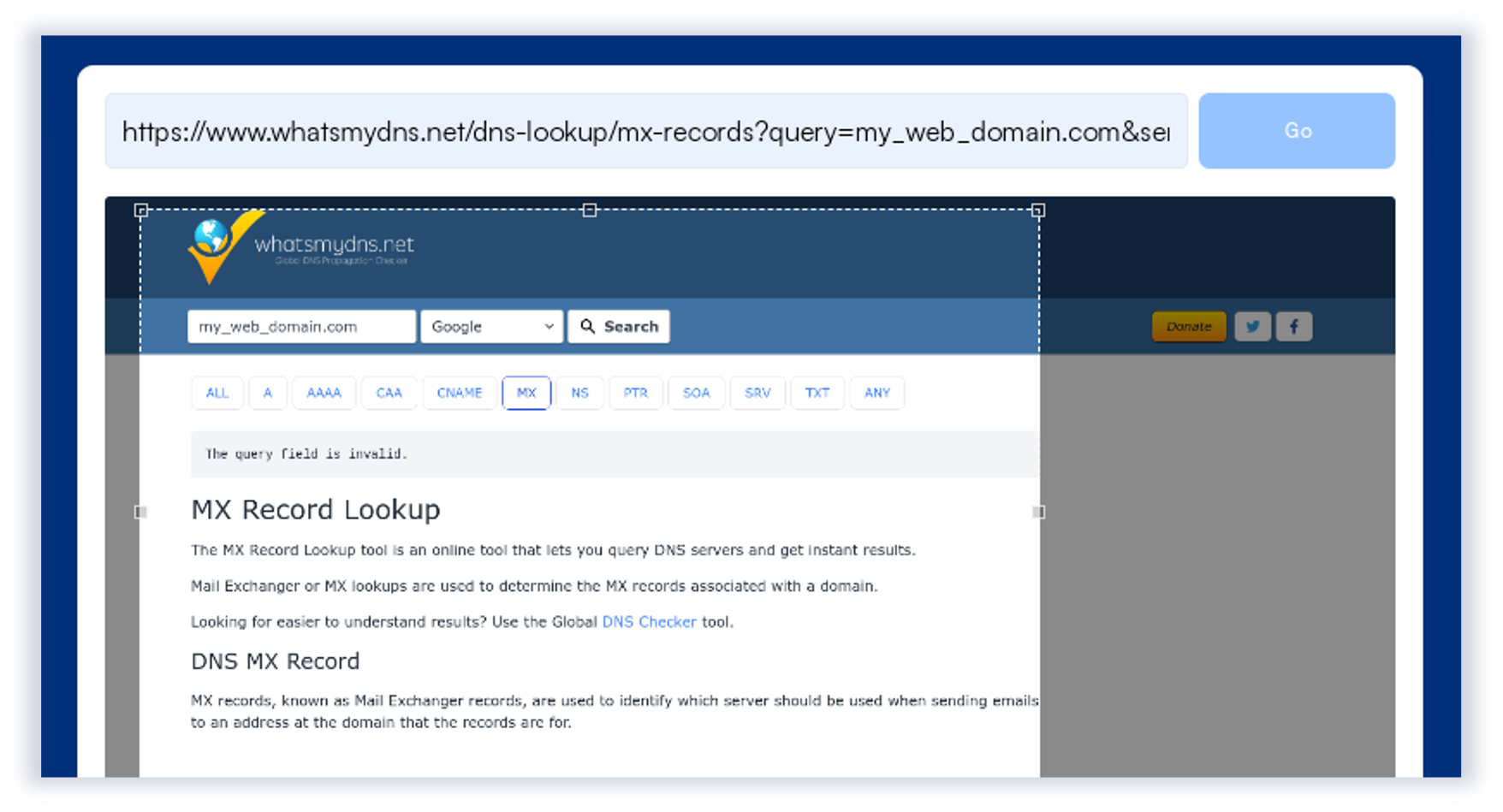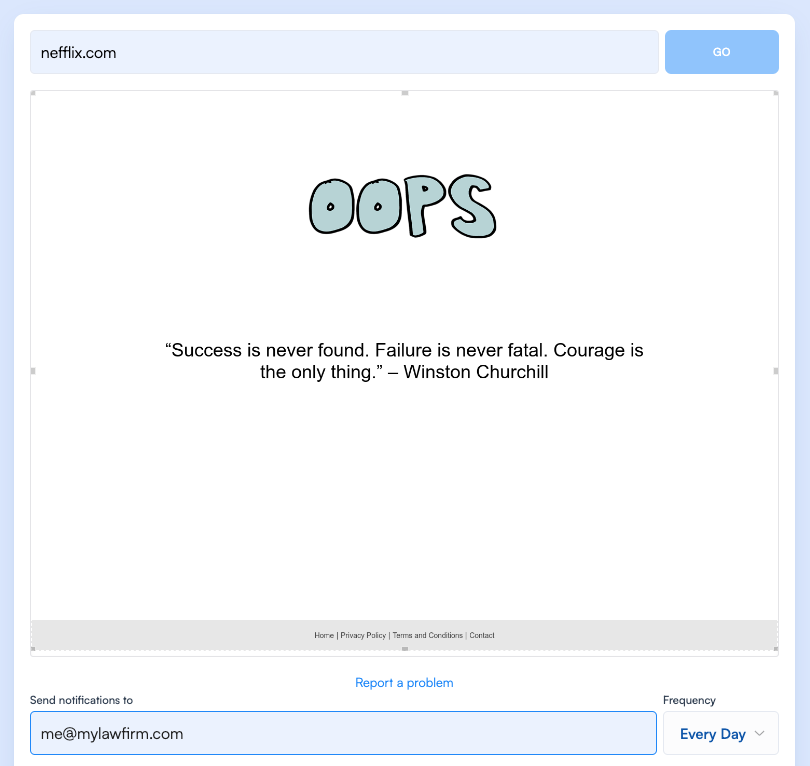Domain Spoofing: Why Web Domain Fraud Monitoring Is Vital For Your Brand
By Emily Fenton
Updated November 8, 2024

The face of a company’s website, as well as its web domain, are some of the two first impressions of a brand a potential customer has when considering buying a product, or checking out a service. Given its resonance, an established business online should know -- and even expect -- the threat of online fraud and impersonation.
One unsavory tactic is domain spoofing – the registration of web domain “lookalikes” to use in phishing emails, or to impersonate your website.. Web domain fraud cases like these require legal action, such as a cease-and-desist letter, to protect your organization.
It's essential, then, to be keeping an eye out for potentially fraudulent web domains, such as monitoring a list of MX records from a site like whatsmydns.net, or new activity from web domains that may be of concern. But manually rechecking these web pages is time-consuming, and an ineffective approach to safeguarding your brand from fraud.
Website change monitoring tools, like Visualping automatically monitor any web page for you, and notify you when there's a change.
Visualping can track web pages for updates in real-time, alerting you as soon as there's a change that requires your attention -- an online list of MX records for new suspicious registrations , or fraudulent websites with new activity you need to know about.
Whether for your own organization, or to legally support your clients, leveraging automation is the easiest -- and most effective -- way to protect against web domain fraud.
What is Domain Spoofing?
Domain spoofing is when a domain name is strikingly similar to an established brand, and mimics major collateral for that domain in order to pose as a legitimate site. This could be through the use of a name, or logo.
Common tactics include domain typosquatting -- leveraging common URL misspellings, or homoglyphs, using similar alphabet characters, to lure unsuspecting traffic to a malicious website. Another tactic is copycatting, or visually mirroring a legitimate site – both with the aim of making a profit.
Domain spoofing is a profitable platform for cybercriminals and scammers. Domains are relatively cheap to register, and provide an opportunity for direct interaction with users. Spoofed domains can then be used to steal customer data through phishing, transactions, or other methods to steal personal information.
Is Domain Spoofing Illegal?
Yes, domain spoofing is illegal in the US, and many other countries. You're entitled to take legal action. The Internet Corporation for Assigned Names and Numbers (ICANN) and the US Federal government have established special legislative acts and policies for protecting trademark owners from domain name spoofing . This is mainly with the ACPA (Anticybersquatting Consumer Protection Act).
The ACPA is federal legislation that regulates the registration of domain names, to prevent the registration of names identical, or unmistakably similar, to trademarked brand names. It made typosquatting illegal back in 1999.
Through ICANN and the ACPA, reclaiming a domain is often resolved relatively quickly.
When someone owns a domain name that is substantially related or similar to a trademarked name, they have to prove their legal intent in owning this domain name. Otherwise, it's considered bad faith registration with malicious intent, and they may be forced to transfer or forfeit this domain name.
In 2008, Verizon sued OnlineNIC Inc for a bad faith registration of 663 nearly identical domain names, using Verizon trademarks. Verizon was awarded $33.15 million in damages, the largest amount of damages ever awarded in a cybersquatting case.
In order to take legal action, though, you need to be able to identify and catch instances of web domain fraud to begin with – preferably, before any damage to your brand and, ultimately, your bottom line.
Why Should Your Organization Care About Web Domain Fraud?
Safeguard your Bottom Line and Brand
Organizations should protect themselves from web domain fraud. At scale, spoofed domains can have a massive impact on an organization's bottom line, as would-be customers are lost to attackers.
But, beyond the loss of revenues from lost customers, domain fraud is a stain on the brand's image. Tricked customers deem your brand the trickster. Customers will mistrust your domain and brand, and halt their engagements with your carefully crafted marketing emails and campaigns.
Trust and brand reputation will be eroded -- and this intangible loss is something that can take years to recover from. The loss in revenues multiplies.
Taking action to protect your organization from domain spoofing , then, should be considered well worth your time and resources.
This may include sending a cease-and-desist letter to the site admin or domain registrant of the fake website -- information you can get from domain registrant search services, like ICANN. You can also notify the domain registrar about the misuse. Registrars like GoDaddy.com are aware of the problem and might be able to help.
What is Domain Fraud Monitoring?
Domain fraud monitoring is the process of proactively detecting domain spoofing and typosquatting, , so that you can take action against scammers copying your domain and/or website.
Web domain fraud monitoring enables an organization to take control of its online reputation by detecting malicious activity and taking action to avoid costly brand and security incidents, safeguard customer engagement and save time and money.
The Pains of Manual Domain Fraud Monitoring
Manually Rechecking RX Records and Website Activity is Inefficient
Web domains can be protected both offensively and defensively.
Defensively, it's important for an organization's legal and security team to maintain a repository of owned domains and subdomains, as well as proactively register similar domain names. This reduces the chances of attackers buying similar, look-a-like domainsOffensively, it's about being able to detect fraud quickly, so that you can take down malicious domains right away, to reduce the risk of harm.
But manual domain monitoring can be challenging and time-consuming -- especially for larger organizations with numerous domains and subdomains to track and, if a major brand, heightened risk of fraud to occur.
Legal teams, charged with keeping pace with many clients' subsidiary brands and domains, would also find manual domain monitoring a challenge.
Automate Web Fraud Monitoring with Visualping
Save Time by Automatically Scanning for Fraudulent Web Domains and Activity
Using automation tools is generally recommended for organizations looking to protect their brand against web domain fraud, or their clients'.
By using software to automate this process, you can efficiently scan many lists of RX records and website activity, at any one time, for changes that require your attention.
Visualping is a real-time website change monitoring tool that can notify you of updates from any web pages on the internet -- lists of MX records, from sites like whatsmydns.net, or any web page activity.
 .
.
Keep Up with Web Domain Fraud
Real-Time Web Monitoring
Visualping is a real-time website change monitoring tool that can notify you of updates from any web pages on the internet -- lists of MX records, from sites like whatsmydns.net, or any web page activity.
Visualping offers real-time monitoring features, so you can detect fraudulent activity within 5 minutes, and respond right away to threats.
Understand Web Page Changes Easily
Visualping notifies you and your team with a screenshot of the page changes, highlighted for you to easily understand, so you can stay in the know.
Monitor More Than Ever Before
With the bulk monitoring and management features, you can monitor as many web pages as you need to stay on top of fraudulent web activity.
Protect Your Site Against Domain Spoofing with Visualping
Getting started with the tool is easy.
Just tell Visualping which URL you want to monitor, and select the area of the page you care about. Visualping will check it as frequently as you specify, and send you an email alert when there's a change.
How to Monitor for Web Domain Fraud with Visualping
Step 1: Copy and Paste the Page URL You Want to Track into the Search Bar on Visualping’s Homepage
To begin, simply go to Visualping homepage, and copy and paste the URL from the web source you want into the search engine.
 .
.
Step 2: Select the Part of the Page You Want to Monitor
Next, select the specific area of the page that’ll update with the changes you care about. Or, you can just monitor the whole page for changes – it’s up to you.
Step 3: Choose How Often You Want Visualping to Check the Page for Changes
To set how often Visualping checks the page, select your frequency of checks. Depending on the urgency of your subject matter, Visualping can check a page anywhere from every 5 minutes, to once a month.
Step 4: Enter the Email Address You Want to Use to Receive Updates
Visualping needs an email address to send alerts to.
You can easily change it later from your Visualping account page, but you need to enter an email address at this point in the sign up process, in order to activate your account.
You’re almost done!
Step 5: Check Your Email, Make a Password, and You’re Done
Once you’ve entered your email, you’ll get a message in your inbox from Visualping asking you to set your password.
After you’ve completed these steps, you can easily view all of your tracked pages in a single place, in your user dashboard.
Visualping for Business
When you sign up for a Visualping for Business account, you’ll get access to bulk upload features (to prevent you from entering every web page one-at-a-time), and dedicated support to help you set up all the pages exactly how you need them. Be sure to reach out to our team if you have any questions!
Want to be sure a web page is always compliant?
"Sign up with Visualping to detect issues from any web page – before your business is on the line.
Emily Fenton
Emily is the Product Marketing Manager at Visualping. She has a degree in English Literature and a Masters in Management. When she’s not researching and writing about all things Visualping, she loves exploring new restaurants, playing guitar and petting her cats